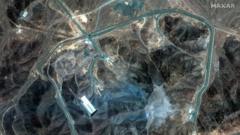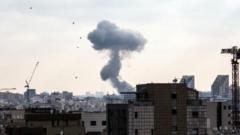In a meticulously planned mission, the US executed airstrikes on Iran's nuclear sites using B-2 stealth bombers and decoys, claiming a strategic victory over Iran's nuclear capabilities.
US Airstrikes: A Covert Operation Targeting Iran's Nuclear Facilities

US Airstrikes: A Covert Operation Targeting Iran's Nuclear Facilities
Details emerge about the successful execution of 'Operation Midnight Hammer' involving B-2 bombers and decoy tactics.
Despite the broad implications of the US's military action, the exact ramifications remain to be seen, as details about the strikes and their aftermath unfold. According to General Dan Caine, Chairman of the Joint Chiefs of Staff, the operation known as 'Operation Midnight Hammer' involved elaborate coordination, including 18-hour continuous flight and multiple mid-air refuelings. The mission started at midnight with a covert departure of American bombers from Whiteman Air Force Base, targeting Iran's heavily fortified nuclear facilities.
B-2 stealth bombers, equipped with powerful bunker-busting munitions, flew largely undetected on their journey to Iran, initially misleading observers with reports of deployments to Guam. The tactics employed were described as "deception efforts," expertly executed to facilitate an undetected approach to the targets—essentially encapsulating a highly secretive military maneuver.
As the aircraft reached the Middle East, support planes joined to safeguard the mission against any hostile responses. US officials reported that Iranian air defenses were inactive during the operation, enabling the bombers to deploy their ordnance without interception.
Thereafter, US forces launched over two dozen Tomahawk cruise missiles towards critical sites in Iran, timed with the B-2 bombers' strikes. The use of Massive Ordnance Penetrators—powerful explosives designed to penetrate deep targets—occurred for the first time in operational warfare, aimed at Iran’s underground facilities including Fordo and Natanz.
More than 75 precision-guided weapons were utilized during a swift two-decade operation that reportedly resulted in significant destruction of Iran's nuclear infrastructure. Yet, despite the military success, questions linger about the long-term impact on Iran's nuclear aspirations, raising uncertainties for future US-Iran relations moving forward.
B-2 stealth bombers, equipped with powerful bunker-busting munitions, flew largely undetected on their journey to Iran, initially misleading observers with reports of deployments to Guam. The tactics employed were described as "deception efforts," expertly executed to facilitate an undetected approach to the targets—essentially encapsulating a highly secretive military maneuver.
As the aircraft reached the Middle East, support planes joined to safeguard the mission against any hostile responses. US officials reported that Iranian air defenses were inactive during the operation, enabling the bombers to deploy their ordnance without interception.
Thereafter, US forces launched over two dozen Tomahawk cruise missiles towards critical sites in Iran, timed with the B-2 bombers' strikes. The use of Massive Ordnance Penetrators—powerful explosives designed to penetrate deep targets—occurred for the first time in operational warfare, aimed at Iran’s underground facilities including Fordo and Natanz.
More than 75 precision-guided weapons were utilized during a swift two-decade operation that reportedly resulted in significant destruction of Iran's nuclear infrastructure. Yet, despite the military success, questions linger about the long-term impact on Iran's nuclear aspirations, raising uncertainties for future US-Iran relations moving forward.






















